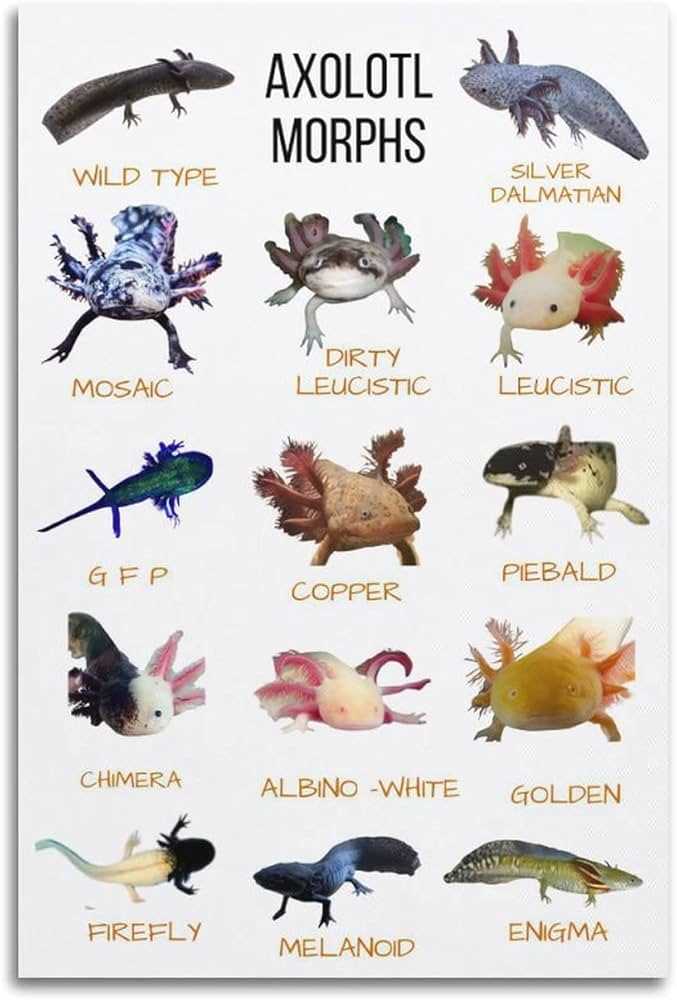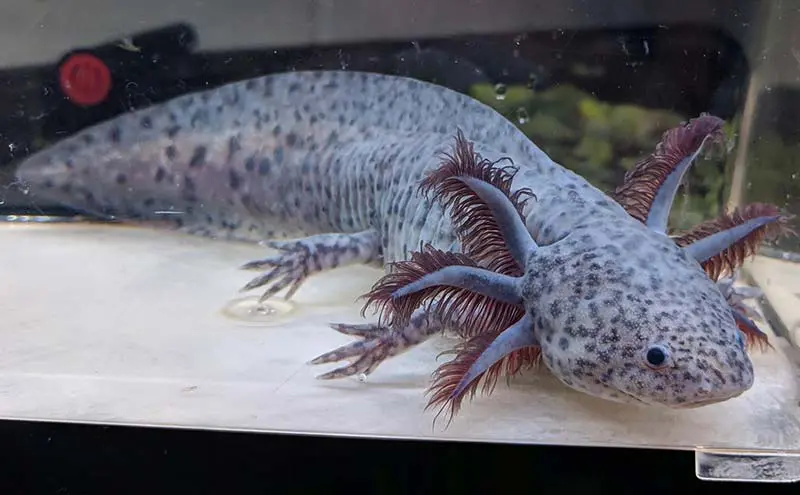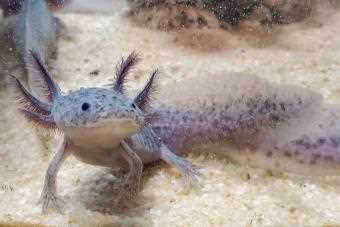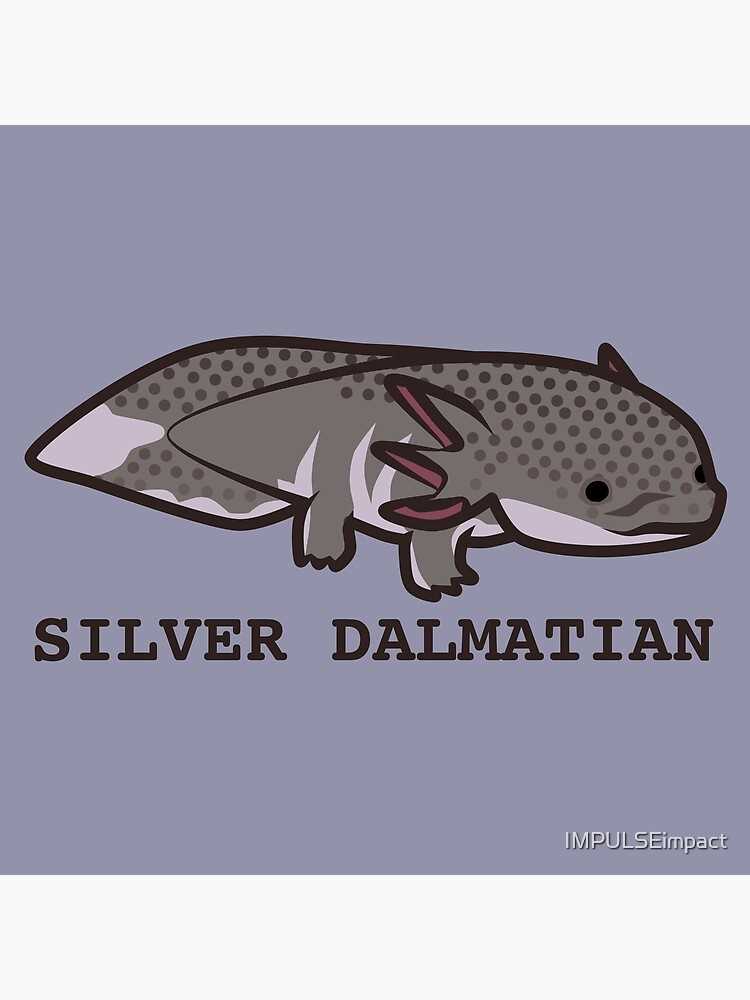
The silver dalmatian axolotl is a fascinating creature that captures the attention of both novice and experienced aquatic enthusiasts. With its unique appearance and captivating coloration, this unusual amphibian is sure to stand out in any tank. With its silver body adorned with striking black spots, it resembles the famous Dalmatian dogs, hence its name.
The silver dalmatian axolotl belongs to the salamander family and is native to Mexico. It is widely recognized for its exceptional ability to regenerate various body parts, including limbs, spinal cord, heart, and even parts of its brain. This remarkable regenerative capability has led researchers to study its genetic makeup in the hope of uncovering future advancements in medical science.
Appearance and Characteristics
The Silver Dalmatian Axolotl is a unique and fascinating creature that stands out for its striking appearance. It is a type of axolotl with a silver-white body covered in black spots, resembling the coat of a Dalmatian dog. These spots can vary in size and shape, giving each axolotl a distinct pattern.
They have a slender and elongated body, with four short limbs ending in delicate webbed fingers and toes. Unlike other amphibians, axolotls never undergo metamorphosis and retain their juvenile-like features throughout their entire lives. They have external gills on the sides of their heads, which they use to breathe underwater.
One of the most fascinating characteristics of the Silver Dalmatian Axolotl is their ability to regenerate lost body parts. Whether it’s a limb, a tail, or even part of their heart, these axolotls can regrow it effortlessly. This remarkable regenerative ability has intrigued scientists and has made the axolotl a subject of extensive research in regenerative medicine.
| Appearance | Characteristics |
|---|---|
| Color: Silver-white body with black spots | Regenerative ability |
| Size: Up to 12 inches (30 cm) | Unique pattern of spots |
| Body shape: Slender and elongated | External gills for breathing |
The Silver Dalmatian Axolotl is a truly captivating creature with its stunning appearance and extraordinary regenerative abilities. It is sure to be a fascinating addition to any aquarium or exotic pet collection.
Origin and Habitat
- In their natural habitat, axolotls are able to regenerate their limbs, spinal cord, heart, and other organs. This unique ability is one of the reasons why they are highly regarded in scientific research.
- Despite their ability to regenerate, the silver dalmatian axolotl remains in its larval form throughout its life, unlike most amphibians that undergo metamorphosis and develop into adults.
- These axolotls have distinctive silver and black speckled patterns on their skin, which give them their dalmatian-like appearance.
Overall, the silver dalmatian axolotl is a fascinating species with an interesting origin and habitat. Their unique characteristics and vulnerability in the wild make them a highly sought-after species among pet enthusiasts and a subject of scientific interest.
Natural Diet of Silver Dalmatian Axolotls
Feeding Patterns and Preferences
Axolotls are carnivorous creatures, primarily feeding on small aquatic invertebrates like worms, insects, and crustaceans in their natural habitat. They have a keen sense of smell and use it to detect prey in the water.
These fascinating creatures are ambush predators and rely on their speed and agility to catch their prey. They possess a wide mouth with small, sharp teeth, enabling them to capture and consume their food effectively.
Recreating the Natural Diet in Captivity

When keeping silver Dalmatian axolotls in captivity, it is essential to mimic their natural diet to maintain their health and vitality. The primary food source for these axolotls is live or frozen proteins like bloodworms, blackworms, daphnia, and brine shrimp, which are readily available from pet stores.
Feeding these axolotls a diet of nutritionally balanced pellets or sinking foods designed specifically for axolotls is also recommended. These pellets usually contain a mix of high-quality protein sources, vitamins, and minerals to meet their dietary needs.
It is crucial to ensure a varied diet for axolotls, offering different food sources to provide a wide range of nutrients. This can include earthworms, small fish, and even small crustaceans like crayfish.
Feeding Frequency and Portions
Axolotls have relatively slow metabolisms and do not require as much food as other aquatic creatures. Overfeeding can lead to obesity and digestive problems. As a general guideline, feeding adult axolotls two to three times a week is sufficient.
When feeding, it is recommended to offer food items that are no larger than the axolotl’s head. This ensures they can consume their food comfortably without any difficulty or stress.
Axolotls are opportunistic feeders and will eat whenever food is available. However, any uneaten food should be promptly removed from the tank to maintain water quality and prevent pollution.
Axolotl Diet in Captivity
The silver dalmatian axolotl has specific dietary needs that must be met in order to ensure its health and well-being in captivity. In its natural habitat, axolotls are opportunistic feeders, meaning they will eat a wide range of prey including insects, small fish, crustaceans, and worms.
It is recommended to feed adult axolotls every 2-3 days, while younger axolotls may require feeding every day. Axolotls are not very active swimmers, so overfeeding can easily lead to obesity, which can have negative effects on their health.
Silver Axolotl Tank Setup
As axolotls are sensitive to bright lights, the tank should be kept in a dimly lit area or fitted with a low-wattage, full-spectrum light. This will prevent stress and help maintain the axolotl’s natural behaviors.
The tank should be equipped with a filtration system that is appropriate for axolotls. Axolotls produce a significant amount of waste, so a filter capable of handling the tank’s size and maintaining proper water parameters is essential. Regular water changes should also be performed to keep the water clean and prevent the buildup of harmful substances.
Apart from the filtration system, it is recommended to have a sponge filter or a canister filter with a pre-filter attachment to prevent the axolotl from getting sucked into the filter and injuring themselves.
Hiding spots, such as caves, tubes, or PVC pipes, should be provided for the axolotl to explore and use as shelter. This will help reduce stress levels and encourage natural behaviors. Live or artificial plants can also be added to the tank, but ensure they are not toxic to axolotls.
The water temperature should be maintained between 16-18°C (60-64°F) to mimic their natural habitat in cool Mexican rivers and prevent the axolotl from overheating and becoming stressed. A reliable aquarium heater should be used to achieve this temperature range.
Overall, creating a suitable tank setup for a silver axolotl requires attention to detail and consideration of the axolotl’s natural needs and requirements. Providing ample space, proper lighting, filtration, and hiding spots will help ensure a healthy and thriving axolotl.
Water Requirements for Silver Dalmatian Axolotl
- Water Temperature: Axolotls prefer to live in cooler water temperatures, ideally between 60-68 degrees Fahrenheit (15-20 degrees Celsius). It is crucial to maintain a consistent temperature in the tank to prevent stressing out the axolotl.
- Water Quality: Axolotls are very sensitive to water quality, so it is essential to keep the water clean and well-filtered. Regular water changes are necessary to remove any accumulated waste or toxins and maintain optimal water conditions for the axolotl.
- Water Depth: Axolotls are neotenic salamanders, which means they retain their larval features even into adulthood and are strictly aquatic. They require a tank with a water depth of at least 12 inches to allow them enough space to swim and move around comfortably.
- Filtration System: A good filtration system is essential to maintain water quality and remove any waste or toxins. A sponge filter or a canister filter with a gentle flow is recommended to avoid causing stress to the axolotl and damaging their delicate gills.
- Tank Decorations: Providing hiding spots and suitable tank decorations such as caves, plants, and rocks is important for the axolotl’s mental and physical well-being. These decorations should be smooth and free of sharp edges to prevent any injuries to the axolotl.
Temperature and Lighting
For lighting, it is best to provide a natural day-night cycle for the axolotl. This can be achieved by using a timer to simulate daylight and darkness. You should aim for 12-14 hours of daylight and 10-12 hours of darkness. Keep in mind that axolotls are sensitive to bright lights, so avoid placing the tank in direct sunlight or using overly bright artificial lighting.
| Temperature | Lighting |
|---|---|
| 60-68 degrees Fahrenheit (15-20 degrees Celsius) | 12-14 hours of daylight, 10-12 hours of darkness |
By providing the appropriate temperature and lighting conditions, you can create a comfortable environment for your silver Dalmatian axolotl and promote its overall well-being.
Handling and Socialization
The silver axolotl is a unique and fascinating aquatic creature that requires proper handling and socialization to thrive in captivity.
Before handling your axolotl, ensure that your hands are thoroughly washed and free from any chemicals or lotions. This is important because any residue or scent on your hands may be harmful to the axolotl’s sensitive skin.
Gently cup your axolotl with both hands and avoid squeezing or applying excessive pressure. Supporting their body properly helps prevent injuries and minimizes stress. Keep in mind that axolotls have a slimy coating on their skin, which may feel slippery to hold.
Axolotls can also be socially interactive creatures, and they may enjoy some gentle socialization. However, it’s crucial to observe their behavior and ensure that they are comfortable with the interaction. If you notice signs of stress such as skin discoloration or excessive twitching, it’s essential to give them space and allow them to rest.
Health and Disease Prevention

Silver Dalmatian Axolotls are generally hardy and resilient creatures, but it is still important to take proper care of their health to prevent any potential diseases or illnesses. Here are some tips for maintaining the well-being of your axolotl:
1. Clean Water
One of the most crucial factors in preventing diseases in axolotls is maintaining clean water conditions. Regularly monitor the water quality parameters such as ammonia, nitrite, and nitrate levels using appropriate test kits. Keep the water clean and free from any harmful substances or pollutants. Perform regular water changes to ensure a healthy and clean environment for your axolotls.
2. Suitable Tank Setup
Providing a suitable tank setup is essential for the overall health of your axolotl. Make sure the tank is large enough to accommodate the axolotl comfortably and provide enough swimming space. Avoid using rough or sharp decorations to prevent any injuries to the axolotl’s delicate skin. Maintain a consistent temperature and lighting regime to mimic their natural habitat.
3. Proper Diet and Feeding
Feeding your axolotl a balanced and nutritious diet is crucial for their health. Offer a variety of live or frozen foods such as bloodworms, brine shrimp, and small fish. Avoid overfeeding, as it can lead to obesity and other health issues. Provide suitable hiding spots for your axolotl during feeding to reduce stress and competition with tankmates.
4. Regular Monitoring and Observation
Regularly monitor your axolotl’s behavior, appetite, and overall appearance. Any sudden changes in behavior or physical condition could be an indication of a health problem. Pay attention to any signs of illness, such as loss of appetite, abnormal swimming, or skin discoloration. If you notice any concerns, seek advice from a veterinarian with experience in amphibians.
5. Quarantine and Hygiene

If you plan to introduce new axolotls or any other aquatic species to your tank, it is essential to quarantine them first. Quarantining helps to prevent the spread of potential diseases or parasites. Proper hygiene practices, such as washing your hands before and after handling axolotls or cleaning the tank, can also help prevent the transmission of any harmful pathogens.
By following these guidelines, you can ensure the optimal health and well-being of your silver Dalmatian Axolotl. Remember to provide a clean and suitable environment, a balanced diet, and regular monitoring to prevent any potential health issues and enjoy the companionship of your axolotl for years to come.
Breeding and Reproduction
The breeding and reproduction of the Silver Dalmatian Axolotl is a fascinating process. These unique creatures have the ability to regenerate their limbs, organs, and even their spinal cord, making them incredible specimens to study and observe.
After fertilizing her eggs, the female will lay them on plants, rocks, or other surfaces in the tank. It is crucial to provide suitable surfaces for the eggs to attach to during the breeding process. Once the eggs are laid, both the male and female axolotls will play a role in ensuring their safety.
Once the eggs hatch, tiny axolotl larvae will emerge. These larvae are fully aquatic and have gills for breathing. They will feed on small live foods, such as baby brine shrimp or microworms, until they grow larger and develop into juvenile axolotls.
Dalmatian Axolotl Behavior Traits
The Dalmatian Axolotl is known for its unique and interesting behavior traits. Here are some key characteristics that make this species stand out:
1. Regenerative Abilities:
One of the most remarkable features of axolotls, including the Dalmatian Axolotl, is their ability to regenerate lost body parts. They have the incredible potential to regrow amputated limbs, spinal cord, heart, and even parts of their brain. This makes them a subject of great interest for scientists studying regeneration and tissue engineering.
2. Neoteny:
3. Bottom Dwellers:
4. Nocturnal Behavior:
5. Burrowing Instinct:
The Dalmatian Axolotl has a natural burrowing instinct. They often dig tunnels in the substrate to create hiding places and escape routes. Providing them with a suitable substrate, such as sand or fine gravel, will satisfy their burrowing behavior and give them a sense of security.
6. Cannibalistic Tendencies:
7. Curious and Intelligent:
8. Docile and Gentle:
Axolotl Dalmatian: Interactions with Other Fish
Additionally, axolotls have delicate gills that can be damaged by sharp objects or rough tankmates, so it is crucial to provide plenty of hiding places and smooth surfaces. Live plants, rocks, and caves can create a more natural environment and also help to give fish and axolotls their own space.
Regular observation and monitoring of the tankmates’ behavior is essential. If any aggression or stress is observed, it is recommended to separate the axolotls from the other fish. Keeping the tank well-maintained with proper filtration and feeding the axolotls adequately can also help to minimize aggression and stress.
Common Myths about Axolotls and Dalmatian Axolotls
- Myth 1: Axolotls are mythical creatures.
- Myth 2: Dalmatian axolotls are a separate species.
- Myth 3: Axolotls can regenerate their entire body.
- Myth 4: Axolotls are aggressive and dangerous.
- Myth 5: Dalmatian axolotls need special care and attention.
- Myth 6: Axolotls can live outside of water.
- Myth 7: Dalmatian axolotls are prone to genetic defects.
- Myth 8: Axolotls are easy to care for.
- Myth 9: Dalmatian axolotls have unique abilities.
- Myth 10: Axolotls are loners.
There are several common myths surrounding axolotls and dalmatian axolotls in particular. One of the most prevalent myths is that axolotls are mythical creatures. While they may seem fantastical with their external gills and ability to regenerate limbs, axolotls are real, living creatures.
Another myth is that dalmatian axolotls are a separate species. In reality, dalmatian axolotls are simply a color morph of the regular axolotl species, characterized by their speckled white and black or gray markings.
One popular misconception is that axolotls can regenerate their entire body. While they are indeed capable of regenerating limbs, spinal cords, and some organs, they cannot regrow their entire body.
Contrary to popular belief, axolotls are not aggressive or dangerous. They are relatively peaceful creatures that prefer to eat small live foods and are generally not a threat to other fish or even smaller axolotls.
Another myth surrounding dalmatian axolotls is that they require special care and attention. While they may be visually striking, dalmatian axolotls do not require any different care than regular axolotls.
It is often falsely believed that axolotls can live outside of water. In reality, axolotls are strictly aquatic animals and cannot survive outside of a properly maintained aquarium with water that meets their specific requirements.
Some people mistakenly believe that dalmatian axolotls are prone to genetic defects due to their unique coloration. However, while there may be some genetic variations within the dalmatian color morph, this does not necessarily make them more prone to defects.
While it is true that axolotls are relatively easy to care for compared to some other exotic animals, they still require specific water parameters, a suitable tank setup, and a proper diet to thrive.
There is also a misconception that dalmatian axolotls have unique abilities compared to other axolotls. However, their distinctive coloration is purely a cosmetic trait and does not give them any additional abilities or qualities.
Finally, some people believe that axolotls are loners and do not have social behaviors. In reality, axolotls can be kept together in the same tank and often display social behaviors, such as interacting with each other and even forming pair bonds.
Interesting Facts about Silver Dalmatian Axolotl
The Silver Dalmatian Axolotl is a unique and fascinating creature that captivates the attention of many aquarium enthusiasts. Here are some interesting facts about this stunning amphibian:
Nocturnal Aquatic Salamander
Majestic Spotted Appearance
One of the most striking features of the Silver Dalmatian Axolotl is its unique spotted appearance. It has a silvery-gray body covered in black spots, resembling the famous Dalmatian dog coat pattern. This makes it a visually captivating and sought-after species among axolotl enthusiasts.
The spots on the axolotl are not just for aesthetics; they also serve as a defense mechanism. When threatened, the axolotl can release toxins from its skin, deterring potential predators.
Regenerative Abilities
The regenerative abilities of the Silver Dalmatian Axolotl are truly remarkable. Unlike most amphibians, which undergo metamorphosis and lose their gills to become land-dwelling creatures, axolotls retain their juvenile characteristics throughout their lives. They have the ability to regenerate lost body parts, including limbs, spinal cord, heart, and even parts of their brain.
This unique regenerative ability has attracted the attention of scientists and researchers who are studying axolotls in hopes of unlocking the secrets of tissue regeneration and its potential applications in human medicine.
Breeding and the Threat of Extinction
Despite their incredible regenerative abilities, the Silver Dalmatian Axolotl is currently classified as an endangered species. Due to pollution, habitat loss, and the introduction of non-native species, their natural habitat in Mexico has been greatly devastated. Additionally, they are frequently captured for the pet trade, which further depletes their wild population.
Efforts are being made to breed and conserve the Silver Dalmatian Axolotl in captivity to help prevent their extinction. Many aquarium enthusiasts and organizations are working together to ensure the survival of this beautiful and unique species.

I’m Lena Adams—a product of an unconventional upbringing in the African wilderness. My father, a daring explorer of African wildlife, sparked my fascination with reptiles, a passion that intertwined with the tragic loss of my mother during an expedition, leaving an indelible mark on my life. Driven to understand the creatures that captivated my parents, I embarked on my journey, sharing insights about reptiles, frogs, and lizards on my website. Through my explorations and conservation efforts, I honour my family’s legacy while seeking connections—to the creatures, nature, and the mother whose presence I yearn to understand.
